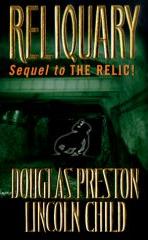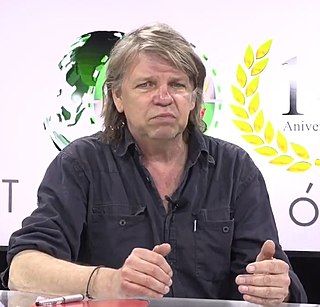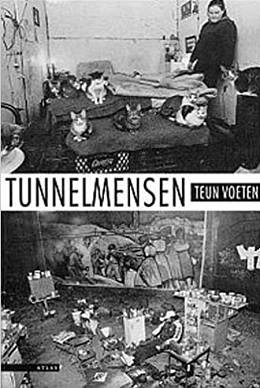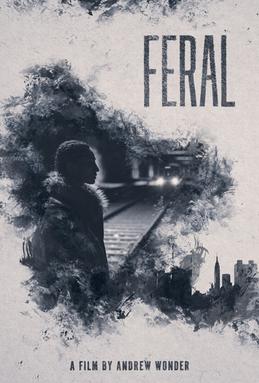Subterranean London refers to a number of subterranean structures that lie beneath London. The city has been occupied by humans for two millennia. Over time, the capital has acquired a vast number of these structures and spaces, often as a result of war and conflict.
An underground city is a series of linked subterranean spaces that may provide a defensive refuge; a place for living, working or shopping; a transit system; mausolea; wine or storage cellars; cisterns or drainage channels; or several of these. Underground cities may be currently active modern creations or they may be historic including ancient sites, some of which may be all or partially open to the public.
Jennifer Ninel Toth is an American journalist and writer.

Dark Days is an American documentary film directed, produced, and photographed by the English documentarian Marc Singer that was completed and released in 2000. Shot during the mid-1990s, it follows a group of people who lived in the Freedom Tunnel section of the Amtrak system at the time. DJ Shadow created new music for the documentary and also let Singer use some of his preexisting songs.

Reliquary is the 1997 New York Times best-selling sequel to Relic, by American authors Douglas Preston and Lincoln Child. The legacy of the blood-maddened Mbwun lives on in Reliquary, but the focus is shifted from the original museum setting to the tunnels beneath the streets of New York City. The book is the second in the Special Agent Pendergast series.

The Beach Pneumatic Transit was the first attempt to build an underground public transit system in New York City. It was developed by Alfred Ely Beach in 1869 as a demonstration subway line running on pneumatic power. The line had one stop in the basement of the Rogers Peet Building, near the old City Hall station, and a one-car shuttle running between the building and a dead end approximately 300 feet (91 m) away. It was not a regular mode of transportation and lasted from 1870 until 1873.
Zoo York is a style and social philosophy inspired by the New York City graffiti art subculture of the 1970s. Its name originates from a subway tunnel running underneath the area of the Central Park Zoo. This tunnel, called the Zoo York Tunnel, or simply "Zoo York," was a haunt of very early "old school" graffiti writers who hung out with the hippies around the Central Park Bandshell in the late 1960s and 1970s.

The Freedom Tunnel is a railroad tunnel carrying the West Side Line under Riverside Park in Manhattan, New York City. Used by Amtrak trains to and from Pennsylvania Station, it got its name because the graffiti artist Chris "Freedom" Pape used the tunnel walls to create some of his most notable artwork. The name may also be a reference to the former shantytowns built within the tunnel by homeless populations seeking shelter and freedom to live rent-free and unsupervised by law enforcement. The tunnel runs approximately 2.6 miles (4.2 km), from 72nd Street to 124th Street.
References to the New York City Subway in popular culture are prevalent, as it is a common element in many New Yorkers' lives.
Chris Pape is an American painter and graffiti artist. He started tagging subway tunnels and subway cars in 1974 as "Gen II" before adopting the tag "Freedom". Pape is best known for his numerous paintings in the eponymous Freedom Tunnel, an Amtrak tunnel running underneath Manhattan's Riverside Park. Prominent paintings in the Freedom Tunnel attributed to Pape include his "self-portrait", featuring a male torso with a spray-can head, and "There's No Way Like the American Way", a parody of Coca-Cola advertising and tribute to the evicted homeless of the tunnel. Another theme of Freedom's work is black and silver recreations of classical art, including a reinterpretation of the Venus de Milo and a full train car recreation of the iconic hands from Michelangelo's Sistine Chapel. Chris Pape also was one of the first documentarians to cover the mole people, homeless living underground in the Freedom Tunnel.
Voices in the Tunnels is a 2008 documentary directed by Vic David, a New York City filmmaker and a graduate from New York University. It explores the lives of people who lived in the New York City Subway tunnels.
Matthew O'Brien is an American author, journalist, editor and teacher who writes about the seedier side of Las Vegas. His most well-known work is the nonfiction book Beneath the Neon, which documents the homeless population living in the underground flood channels of the Las Vegas Valley. He lived in Las Vegas from 1997 to 2017.

The Milwaukee–Dearborn subway is an underground section of the Chicago "L" system in The Loop, Chicago, Illinois. It is 3.85 mi (6.20 km) long and forms the central part of the Blue Line. As of February 2013, the subway serves an average of 44,584 passengers each weekday. Since the subway is served by the Blue Line, it is open to passengers 24 hours a day and 365 days a year.

Beneath the Neon: Life and Death in the Tunnels of Las Vegas is a non-fiction account by author and journalist Matthew O'Brien, with photos by Danny Mollohan. It chronicles the author's time in subterranean Las Vegas. As he pursued a killer who hid in the tunnels, he discovered hundreds of people living underground and interviewed many of them for the book. It was released in June 2007 by Huntington Press.
Sane and Smith were the names used by a New York graffiti duo, composed of David Smith ("Sane") and his brother Roger Smith ("Smith"), active during the 1980s.

Teun Voeten is a Dutch photojournalist and cultural anthropologist specializing in war and conflicts. In 1996 he published the book Tunnelmensen about homeless people living in an old railroad tunnel in Manhattan. He also wrote books on the war in Sierra Leone and made a photo book on the drug violence in Mexico, on which subject he wrote a PhD thesis at Leiden University.

Tunnel People is an anthropological-journalistic account describing an underground homeless community in New York City. It is written by war photographer and anthropologist Teun Voeten and was initially published in his native Dutch in 1996, and a revised English version was published by the Oakland-based independent publishing house PM Press in 2010.

Feral is a 2019 drama thriller film written and directed by Andrew Wonder. The film stars Annapurna Sriram. It is based on actual stories of living underground and working with former homeless individuals.
Celine Held is an American and British film director, writer, and actress. Her debut feature film Topside, co-directed with her partner Logan George, premiered at the 77th Venice International Film Festival. Her short film Caroline that she co-wrote, co-directed and starred in, was nominated for the Short Film Palme d'Or at the 2018 Cannes Film Festival. Her additional short film work has premiered at Sundance Film Festival and at South by Southwest.

Subterranean New York City relates to the area beneath the surface level of New York City; the natural features, man-made structures, spaces, objects, and cultural creation and experience. Like other subterranea, the underground world of New York City has been the basis of TV series, documentaries, artwork, and books.










